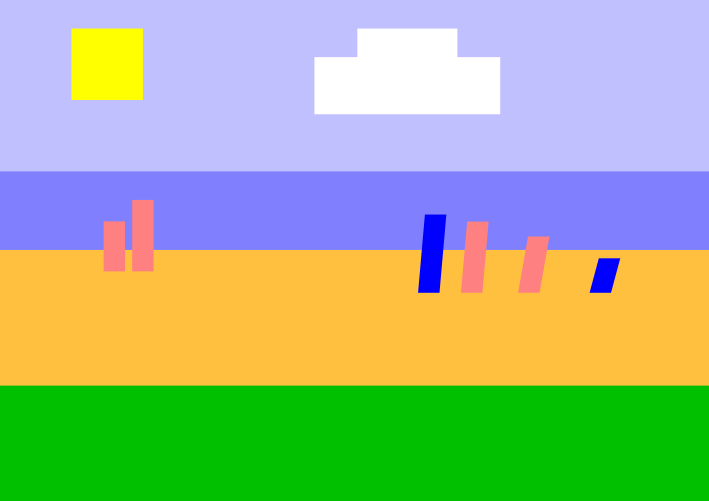
William Overington
Members-
Posts
3,060 -
Joined
-
Last visited
Everything posted by William Overington
-
Not necessarily. This is a discussion forum so I opine that it is reasonable to ask if anyone noticed a meaning implied by the abstract shapes and if so, what meaning. All rectangles, one with each side of equal length so called a square, some sheared so each called a parallelogram. One of them superimposed on another one. Various colours, each colour chosen to try to imply a meaning based on a typical viewer's experiences in United Kingdom culture. That may often be true. So I am wondering if a meaning is self-evident to viewers of this picture. If so, what? Not necessarily. It is often the case that if one puts forward an idea and people read about it in, say, a Letter to the Editor of a magazine, and think it is good then they often make no comment. If they disagree is when they tend to reply. It could be that some people looked at my picture, smiled and thought 'Yes, it is (et cetera et cetera)' but did not post and say so. There is no reason why they needed to post, i'm not suggesting that they should have. So i don't know whether it has worked or not. I suppose it could be perceived as just some shapes drawn by someone who is not good enough at art to produce proper art. A good question to discuss. William
-
affinity designer Steam train landscape
William Overington replied to Kasper-V's topic in Share your work
When I saw your picture, for me it resonated with a picture in a music video. The resonating image is a bit before and a bit after, and at, 3 minutes 20 seconds of the video. But some readers might choose to play the whole video.- 13 replies
-
- steam
- locomotice
-
(and 2 more)
Tagged with:
-
affinity designer Steam train landscape
William Overington replied to Kasper-V's topic in Share your work
A similar locomotive. Midland Railway 2228 Class - Wikipedia- 13 replies
-
- steam
- locomotice
-
(and 2 more)
Tagged with:
-
affinity designer Steam train landscape
William Overington replied to Kasper-V's topic in Share your work
Locomotives of the North Staffordshire Railway - Wikipedia William- 13 replies
-
- steam
- locomotice
-
(and 2 more)
Tagged with:
-
Yet I want to be able to set sizes in integer values that are in one to one correspondence with the dots (as in dots per inch) that a physical printer uses in case I want to get a print. Then I get on the print precisely defined edges to such shapes as filled rectangles. Of inches, millimetres or centimetres, only whole numbers of inches will do that. I am not going to use floating point values with a chunkier measurement unit when a facility to use integer values with a measurement unit that has one to one correspondence with the dots is available to me. As the document is set at 300 dots per inch then the use of pixels does have real meaning in the physical world. William
-
Because use of pixels as the measurement unit allows me to set the position and size of text frames and objects with the maximum available precision using whole numbers. From time to time I buy a few, sometimes two, sometimes five, A3 size prints from a print house. When I start some artwork I do not know whether I may decide to buy some prints. So I make all such artwork ready to be used to produce an A3 size PDF document to send to the print house if I choose to buy some prints of that particular artwork. William
-
My original artwork was A3 size, and I work using pixels as the measurement units. A3 is given as 4960.6 by 3507 pixels. In fact, I have the large rectangles as 5160 pixels wide set though there is 100 pixels outside of the canvas. Exporting as a png is at one-seventh linearly, so 709 by 501. I set the 501 in the box and then the 709 is set automatically. I start with A3 so that I keep open the option to get an A3 size print. William
-
And so it goes on. A post asks a question. One reply already. A few people posting, yet the thread is getting lots of views, Perhaps people watching and ready to declare an interest if the Affinity team announces an intention to have an art show of images produced by some of its customers using Affinity products. William
-
I was thinking that I would like to make progress with writing the novel. That rather than thinking of producing some art using Affinity Designer, which is what I have done on other occasions, other threads. Thinking that it was rather complicated to work out how to continue, I decided that a graphical illustration of which chapters still needed writing would probably be helpful. So I set about producing the diagram using Affinity Designer as a tool to do that, looking at the following web page as I proceeded so as to find out which chapters were not yet written. http://www.users.globalnet.co.uk/~ngo/locse_novel2.htm When the diagram was nearing completion I realized that posting it in this forum it might not be clear as to where the dividing line between the diagram and the background of the Share your work forum web page is located. So I decided at that time that when otherwise complete, I would add a background colour to the diagram. I used the Rectangle Tool with a zero width border, then I set the size and location using the Transform panel, chose the fill colour and then moved it to the back. William


